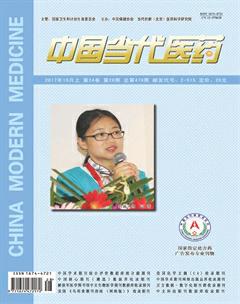輕度認(rèn)知功能障礙患者失匹配負(fù)波的研究
王榮業(yè)+吳東輝+賴文濤
[摘要]目的 探討事件相關(guān)電位失匹配負(fù)波(MMN)對(duì)輕度認(rèn)知功能障礙(MCI)的診斷價(jià)值。方法 選取2015年4~9月在我院記憶門(mén)診就診的MCI患者(MCI組)24例,同期招募性別、年齡、文化程度基本匹配的正常老年人(NC組)21例,采用簡(jiǎn)易智力量表(MMSE)評(píng)價(jià)兩組的認(rèn)知功能,利用事件相關(guān)電位檢查MCI患者和正常對(duì)照組人群的MMN進(jìn)行比對(duì)及分析。結(jié)果 MCI組在Fz、Cz、Pz三電極點(diǎn)的MMN潛伏期和波幅與NC組差異無(wú)統(tǒng)計(jì)學(xué)意義(P>0.05)。結(jié)論MCI患者的聽(tīng)覺(jué)MMN(AMMN)可能無(wú)明顯異常。
[關(guān)鍵詞]輕度認(rèn)知功能障礙;事件相關(guān)電位;失匹配負(fù)波
[中圖分類(lèi)號(hào)] R74 [文獻(xiàn)標(biāo)識(shí)碼] A [文章編號(hào)] 1674-4721(2017)10(a)-0055-03
[Abstract]Objective To explore the diagnostic value of event-related potential mismatch negativity (MMN) for mild cognitive impairment (MCI).Methods From April to September in 2015,24 patients with MCI (MCI group) treated in our memory clinic were selected.At the same period,21 normal old people (NC group) with matched sex,age,and educational levels were recruited.The cognitive function in two groups was evaluated by mini-mental state examination (MMSE).MMN was compared and analyzed in MCI patients and participants in normal control group by event-relatedexamination.Results In MCI group,the latent period and amplitude of MMN in three electrode points of Fz,Cz,and Pz were not displayed statistical differences compared with the normal control group (P>0.05).Conclusion Auditory MMN (AMMN) in MCI patients may be not in significant abnormality.
[Key words]Mild cognitive impairment;Event-related potentials;Mismatch negativity wave
事件相關(guān)電位(event-related potentials,ERPs)作為大腦認(rèn)知功能的客觀檢測(cè)指標(biāo),反映了認(rèn)知過(guò)程中大腦神經(jīng)電生理的變化,已被用于視知覺(jué)、注意、記憶、語(yǔ)言等多領(lǐng)域的基礎(chǔ)研究。輕度認(rèn)知功能障礙(mild cognitive impairment,MCI)被作為阿爾茨海默病(Alz-heimer disorder,AD)的早期階段表現(xiàn)[1],尚無(wú)公認(rèn)易獲得的生物標(biāo)記。越來(lái)越多的研究表明,ERPs為AD的診斷提供重要的客觀檢測(cè)指標(biāo),相比正常人群,MCI患者和AD患者均在P300、N400、P600等ERPs晚期成分出現(xiàn)異常,這些晚期成分有可能成為AD的生物學(xué)指標(biāo)及MCI患者發(fā)展成AD的預(yù)測(cè)指標(biāo)[2-4]。ERPs的晚期成分更多與高級(jí)的認(rèn)知功能相關(guān),早期成分(如N1、MMN等)與初級(jí)認(rèn)知功能關(guān)系密切,然而關(guān)于MCI患者的ERP早期成分的研究較少且存在較大爭(zhēng)議[5-10],因此,本研究比較并分析MCI患者和正常對(duì)照組人群的失匹配負(fù)波(MMN),探討MMN對(duì)MCI患者的研究?jī)r(jià)值,為早期診斷AD提供新的思路。
1資料與方法
1.1一般資料
選擇2015年4~9月在我院記憶門(mén)診就診的MCI組患者24例,其中男性9例,女性15例,年齡51~84歲,平均67.38歲。入組人員符合Peterson等[11]于1999年制訂的MCI診斷標(biāo)準(zhǔn):①有記憶障礙的主訴,有知情者證實(shí);②可查出與年齡和受教育程度不相符的記憶損害;③總體認(rèn)知分級(jí)量表輕度異常,即總體衰退量表(global deterioration scale,GDS)2~3級(jí)或臨床癡呆評(píng)定量表(clinical dementia rating,CDR)0.5分, 簡(jiǎn)易智力量表(min-mental state examination, MMSE)24~27分;④一般認(rèn)知功能正常;⑤日常生活能力保持正常;⑥除外癡呆或任何可以導(dǎo)致腦功能紊亂的軀體和精神疾患。同時(shí)招募性別、年齡、文化程度與MCI組基本匹配的正常老年人21例作為正常對(duì)照組(NC組),其中男性6例,女性15例,年齡54~78歲,平均65.29歲,無(wú)認(rèn)知損害表現(xiàn),無(wú)記憶障礙主訴;MMSE評(píng)分>27分,臨床CDR評(píng)分=0分。
1.2研究方法
量表評(píng)估:采用中文版MMSE評(píng)價(jià)兩組的認(rèn)知功能。該量表內(nèi)容包括以下7個(gè)方面:時(shí)間定向力,地點(diǎn)定向力,即刻記憶,注意力及計(jì)算力,延遲記憶,語(yǔ)言,視空間。共30項(xiàng)題目,每項(xiàng)回答正確得1分,回答錯(cuò)誤或答不知道評(píng)0分,量表總分為0~30分。測(cè)試時(shí)間<10 min。CDR量表評(píng)定的領(lǐng)域包括記憶,定向力,判斷與解決問(wèn)題的能力,工作和社會(huì)交往能力,家庭生活和個(gè)人業(yè)余愛(ài)好,獨(dú)立生活自理能力,以上6項(xiàng)功能的每個(gè)方面分別作出從無(wú)損害到重度損害5級(jí)評(píng)估,但每項(xiàng)功能的得分不疊加,而是根據(jù)總的評(píng)分標(biāo)準(zhǔn)將6項(xiàng)能力的評(píng)定綜合成總分,其結(jié)果以0、0.5、1、2、3分表示,分別判定為正常、可疑、輕、中,重度5級(jí)。endprint
ERPs測(cè)試:實(shí)驗(yàn)室隔音、安靜,保持一定的光亮度和溫度。被試在實(shí)驗(yàn)過(guò)程中保持清醒,全身肌肉放松。使用德國(guó)Brian Products公司腦誘發(fā)電位儀,標(biāo)準(zhǔn)32導(dǎo)、Ag-AgCI電極,以及國(guó)際10-20系統(tǒng)分布的電極帽。濾波帶通為0.05-200Hz,采樣率為1000 Hz。參考電極置于左側(cè)乳突,所有電極處的頭皮電阻<10 kΩ。為了監(jiān)測(cè)眼動(dòng)和眨眼,同時(shí)記錄眼電(electro-oculographic,EOG)信號(hào),置于右眼眶下正中。
MMN范式:采用260組成對(duì)視-聽(tīng)刺激(分為兩個(gè)block,block之間休息2 min),每組成對(duì)視聽(tīng)刺激包括先呈現(xiàn)200 ms的視覺(jué)刺激,間隔300 ms后再呈現(xiàn)150 ms聽(tīng)覺(jué)刺激,每組成對(duì)刺激間隔2 s,被試要求只關(guān)注視覺(jué)刺激忽視聽(tīng)覺(jué)刺激[7,12-13]。
視覺(jué)刺激包括數(shù)字1、3、5、7、9和字母a、e、c、u、i,要求被試只對(duì)數(shù)字進(jìn)行右手按鍵反應(yīng),字母不反應(yīng)。聽(tīng)覺(jué)刺激包括偏差刺激80 dB聲壓級(jí)(SPL)的1500 Hz純音,出現(xiàn)概率為20%,標(biāo)準(zhǔn)刺激80 dB聲壓級(jí)(SPL)的1000 Hz純音,出現(xiàn)概率為80%。
腦電數(shù)據(jù)離線分析時(shí)首先剔除異常的腦電信號(hào),并用EOG相關(guān)法消除眼電對(duì)腦電的影響,接著偽跡剔除±100 μV之外的腦電波幅,最后對(duì)偏差刺激進(jìn)行疊加平均。Fz、Cz、Pz共3個(gè)電極點(diǎn)參與分析,分析時(shí)根據(jù)總平均圖和過(guò)往研究確定MMN時(shí)間窗口均為125~260 ms[7]。
1.3統(tǒng)計(jì)學(xué)處理
采用SPSS 22.0統(tǒng)計(jì)軟件分析數(shù)據(jù), 計(jì)量資料以均數(shù)±標(biāo)準(zhǔn)差(x±s)表示, 采用多因素重復(fù)測(cè)量和多因素方差分析,以P<0.05為差異有統(tǒng)計(jì)學(xué)意義。
2結(jié)果
2.1兩組人口學(xué)變量的比較
MCI組與NC組在性別、年齡、文化程度方面差異均無(wú)統(tǒng)計(jì)學(xué)意義(P>0.05)(表1)。
2.2兩組不同電極點(diǎn)MMN潛伏期、波幅的比較
與NC組比較,MCI組在Fz、Cz、Pz三電極點(diǎn)的MMN潛伏期均有所縮短, 但差異均無(wú)統(tǒng)計(jì)學(xué)意義(P>0.05) (表2)。與NC組比較,MCI組在Fz、Cz、Pz三電極點(diǎn)的MMN波幅差異均無(wú)統(tǒng)計(jì)學(xué)意義(P>0.05)(表3)。
3討論
MMN是一種內(nèi)源性ERPs, 它能不依賴注意的作用就可明顯出現(xiàn),因此MMN能客觀反映聽(tīng)覺(jué)皮層的功能狀態(tài)及大腦對(duì)新異刺激的自動(dòng)加工過(guò)程[14]。MMN根據(jù)感覺(jué)通道的不同,可分為聽(tīng)覺(jué)MMN(AMMN)和視覺(jué)MMN(VMMN),聽(tīng)覺(jué)MMN反映聽(tīng)覺(jué)記憶痕跡的失匹配,而視覺(jué)MMN不僅反映視覺(jué)記憶痕跡的失匹配,而且還反映刺激偏差造成的不應(yīng)效應(yīng)差異[15],因此,由于實(shí)驗(yàn)范式的不一致,MCI的MMN研究出現(xiàn)較大的爭(zhēng)議。
Lindin等[7]使用聽(tīng)覺(jué)MMN研究MCI患者的前注意加工,發(fā)現(xiàn)聽(tīng)覺(jué)MMN潛伏期短于NC組,但差異無(wú)統(tǒng)計(jì)學(xué)意義,而聽(tīng)覺(jué)MMN波幅潛伏期明顯短于NC組。Ji等[8]的研究發(fā)現(xiàn),聽(tīng)覺(jué)MMN潛伏期明顯延長(zhǎng)而波幅不存在差異。本研究也采用聽(tīng)覺(jué)MMN的實(shí)驗(yàn)范式,所得結(jié)果在潛伏期上與Lindin等[7]的研究結(jié)果一致,而波幅的結(jié)果則與Ji等[8]的研究結(jié)果一致,于此同時(shí),Lindin等[7-8]的研究結(jié)論均不同程度地受被試年齡因素所制約。另一方面,關(guān)于MCI患者的視覺(jué)MMN研究,結(jié)果顯示,MCI患者的視覺(jué)MMN波幅存在異常且與認(rèn)知障礙關(guān)系密切[5,10],因此,MCI患者在認(rèn)知加工的前注意階段,視覺(jué)信息的自動(dòng)加工出現(xiàn)明顯異常,而聽(tīng)覺(jué)信息的自動(dòng)加工無(wú)明顯異常。
本研究采用臨床對(duì)照的設(shè)計(jì)方法,MCI患者和正常人群使用嚴(yán)格的診斷標(biāo)準(zhǔn)和國(guó)際通用的篩查量表進(jìn)行有效區(qū)分,同時(shí)采用雙盲法進(jìn)行ERPs數(shù)據(jù)的采集,但本研究作為橫斷面研究,樣本量偏少,實(shí)驗(yàn)范式較為單一,因此,在未來(lái)的研究中,我們不僅可以通過(guò)樣本量的增加去探索更多與MCI有關(guān)的ERPs成分,而且可以在多種ERPs成分的基礎(chǔ)上結(jié)合精神影像的方法,為更早、更準(zhǔn)確地篩查出MCI患者提供較客觀的方法。
[參考文獻(xiàn)]
[1]Morris JC.Revised criteria for mild cognitive impairment may compromise the diagnosis of Alzheimer disease dementia[J].Arch Neurol,2012,69(6):700-708.
[2]Olichney JM,Taylor JR,Gatherwright J,et al.Patients with MCI and N400 or P600 abnormalities are at very high risk for conversion to dementia[J].Neurology,2008,70(19):1763-1770.
[3]Olichney JM,Yang JC,Taylor J,et al.Cognitive event-related potentials:biomarkers of synaptic dysfunction across the stages of Alzheimer′s disease[J].J Alzheimers Dis,2011,26(Suppl 3):215-228.
[4]Parra MA,Ascencio LL,Urquina HF,et al.P300 and neuropsychological assessment in mild cognitive impairment and Alzheimer dementia[J].Front Neurol,2012.,3:172.
[5]Tales A,Haworth J,Wilcock G,et al.Visual mismatch negativity highlights abnormal pre-attentive visual processing in mild cognitive impairment and Alzheimer′s disease[J].Neuropsychologia,2008,46(5):1224-1232.endprint
[6]Mowszowski L,Hermens DF,Diamond K,et al.Reduced mismatch negativity in mild cognitive impairment:associations with neuropsychological performance[J].J Alzheimers Dis,2012,30(1):209-219.
[7]Lindin M,Correa K,Zurron M,et al.Mismatch negativity (MMN) amplitude as a biomarker of sensory memory deficit in amnestic mild cognitive impairment[J].Front Aging Neurosci,2013,5:79.
[8]Ji LL,Zhang YY,Zhang L,et al.Mismatch negativity latency as a biomarker of amnestic mild cognitive impairment in chinese rural elders[J]. Front Aging Neurosci,2015,7:22.
[9]Stothart G,Kazanina N,Nnen R,et al.Early visual evoked potentials and mismatch negativity in Alzheimer′s disease and mild cognitive impairment[J].J Alzheimers Dis,2015,44(2):397-408.
[10]Idrizbegovic E,Hederstierna C,Rosenhall U.Mismatch Negativity and Ear Laterality in Alzheimer′s Disease and in Mild Cognitive Impairment[J].J Alzheimers Dis,2016,53(4):1405-1410.
[11]Petersen RC,Smith GE,Waring SC,et al.Mild cognitive impairment:clinical characterization and outcome[J].Arch Neurol,1999,56(3):303-308.
[12]Escera C,Alho K,Winkler I,et al.Neural mechanisms of involuntary attention to acoustic novelty and change[J].J Cogn Neurosci,1998. 10(5):590-604.
[13]Escera C,Yago E,Alho K.Electrical responses reveal the temporal dynamics of brain events during involuntary attention switching[J]. Eur J Neurosci,2001. 14(5):877-883.
[14]nen R,Sussman ES,Salisbury D,Shafer VL.Mismatch negativity (MMN) as an index of cognitive dysfunction[J].Brain topography,2014,27(4):451-466.
[15]Kimura M,Katayama J,Ohira H,et al.Visual mismatch negativity:new evidence from the equiprobable paradigm[J].Psychophysiology,2009,46(2):402-409.
(收稿日期:2017-06-20 本文編輯:許俊琴)endprint
- 中國(guó)當(dāng)代醫(yī)藥的其它文章
- 腎炎康復(fù)片治療腎小球腎炎的臨床應(yīng)用效果研究
- 免疫抑制劑聯(lián)合血液透析治療原發(fā)性腎病綜合征并發(fā)急性腎功能衰竭患者的效果觀察
- 經(jīng)尿道前列腺雙極等離子電切術(shù)和前列腺電切術(shù)治療良性前列腺增生的效果對(duì)比
- 前列地爾注射液在老年急性腎損傷中的應(yīng)用分析
- C反應(yīng)蛋白預(yù)測(cè)遠(yuǎn)端輸尿管結(jié)石自排的應(yīng)用價(jià)值
- 電動(dòng)吸痰機(jī)聯(lián)合全自動(dòng)洗胃機(jī)在急診中毒患者洗胃中的應(yīng)用

